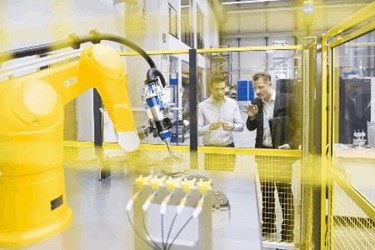MIT's Humatics Equip Industrial Robots With Radar
By Jof Enriquez,
Follow me on Twitter @jofenriq

A spin-off from Massachusetts Institute of Technology (MIT) is equipping industrial robots with radar sensors to help advance machine-human collaboration.
Humatics, spun out from MIT in 2015, has developed a microlocation system and analytics software it calls the Spatial Intelligence Platform, which utilizes inexpensive radio-frequency technology to track transponder targets, at ranges up to 30 meters, with millimeter-scale precision.
The average industrial robot is unable to sense its environment and usually is confined to a cage to protect human workers. However, with more advanced sensors and algorithms, the robots’ purpose is being expanded and they have become safer than ever before.
Humatics' tracking system makes it possible to make industrial robots function more safely alongside their human counterparts, possibly rendering safety cages unnecessary.
“We very much see this enabling robots to live in human environments,” says David Mindell, a professor in the aeronautics and astronautics department at MIT, as well as co-founder and CEO of Humatics, reports MIT Technology Review.
Humatics says that, for now, it is "staying pretty tight-lipped" about their "breakthrough" tracking technology. But it claims that their system is a superior alternative to current Global Positioning System (GPS) satellites and radio-based local area positioning technologies and camera-based systems, in locating targets precisely, at a fraction of a cost.
Humatics says that it is currently piloting the system with “key industrial automation and manufacturing partners.”
The company says it will use the proceeds from its $18 Million Series A financing announced this week to complete product development and prepare for commercialization of the Spatial Intelligence Platform, which it plans to start selling or license in 2018.
Retail giant Amazon already is using fairly advanced robots in warehouses and fulfillment centers to help employees pack and move orders more efficiently. Microlocation technology could push this machine-human collaboration much further, according to Mindell.
“We founded Humatics to locate people, places and things in an increasingly connected world,” he said. “For robots, next-generation manufacturing equipment, drones, and other autonomous systems to safely and seamlessly interact with people and their environments, we need more precise and robust positioning. Our breakthrough system captures millimeter-scale position and motion data at low cost, indoors and out, creating an entirely new product category – microlocation.”
The technology can also be used to monitor and improve the performance of human workers. A software system can provide analytics on workers’ movements, for example, to pinpoint which ones are repetitive or redundant. The company also will provide an application programming interface to enable developers to build their own applications.
On its website, Humatics identifies examples of future applications of its microlocation technology, including:
- Augmented reality systems registering images to millimeter precision.
- Drones hovering with exquisite precision while making millimeter-scale maps.
- Military aircraft landing safely in all conditions.
- Professional athletes optimizing their performance.
- Autonomous vehicles driving with enhanced confidence.
- Precise prediction of human motion in healthcare settings, predicting and avoiding injury, and speeding recovery.
